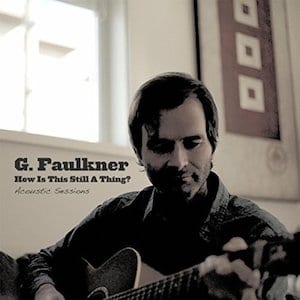 G. Faulkner: How Is This Still a Thing?
G. Faulkner: How Is This Still a Thing?
Self-Released – Out Now
As a working musician who is carrying on a lifelong love affair with the guitar, I have always struggled to reconcile what I feel to be the ongoing paradox of the instrument: its six strings and twenty-two frets represent an infinite grid of future possibilities yet its culture tends to venerate the achievements, sounds, and music of the past, frequently using them as benchmarks against which the present is assayed.
It’s an irresolvable tension, of course. Imitation is in the DNA of the instrument. Most of us begin playing because we’re inspired by what we hear and want to recreate it, after all. Few of us go on to innovate or add to the instrument’s vocabulary; and yet music daily continues to be made that moves, amazes, soothes, and inspires us using nothing more than the building blocks carved out by the innovators to the past. Confronted by this reality, sometimes, as Frank Zappa once said, all we can do is shut up and play our guitars.
Still, the arrival of G Faulkner’s How Is This Still a Thing? prompts me to revisit the above ideas. As with 2015’s Spring Mix: Demo Recordings 1995-2015 and 2016’s Hollow Moon, G. Faulkner’s influences are clearly worn on his sleeve in his latest self-release. Devotees of the altered tunings used in the acoustic British Folk scene circa the 1960’s and 1970’s will recognize the circular picking arrangements used; while those interested in lo-fi Americana approaches will identify with the stripped back production and minimalist arrangements generally.
In this context, opener One Mic One Guitar stands as a manifesto for the album. The woody attack drives a skeletal, relentless pattern which like the title track and Salish Journey bring to mind (among others) the percussive snap of early John Martyn, before the man discovered an Echoplex and invented ambient music. John’s roots and influences were equally clearly displayed at this point, of course, so this is no bad thing. There is a pleasure in the hypnotic quality these tracks achieve, as there is in the sense of intimacy that the production engenders.
Driven by similarly mesmeric repetitive chord changes, the songs Sell Your Bed, Luck Always Follows, and Light on the Road dispense their lyrics with a wry casual, throwaway offhandedness that suits them. Others have done far less, far less engagingly with far more verbosity. I can hear why G. Faulkner notes Lou Reed, Syd Barrett, and Mason Jennings as stylistic nods, but there are echoes of Eliot Smith in there too.
The presence of Bron Y Aur ends the album on an interesting note. I don’t know if research has been done into how musicians approach playing someone else’s material against their own, but I’d be interested to read it if it has. In my own experience, you sometimes launch into a cover with more confidence simply because you know it works. This seems to be the case here – the playing is self-assured and delivered with conviction.
So, does it answer the conundrum I sometimes wrestle with? Well, no. But How Is This Still a Thing? isn’t supposed to. Its charm lies in its easy, intimate delivery; its low-fi approach; and an engaging sense of humanity that comes from someone just playing what matters to them simply because it matters to them.
https://youtu.be/-kxBZAOkWMI

